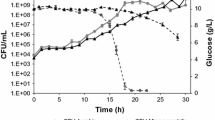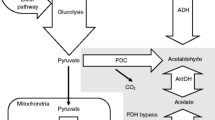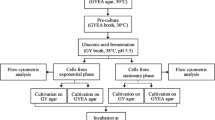Abstract
The pH, viability and flocculation during the growth of Saccharomyces cerevisiae NCYC 1214 in rich medium (YEPD) and in chemically defined medium (YNB) were compared. As the pH fell from 5.3 to 2.2, the viability fell to 20% and no flocculation was observed in YNB medium, despite the high flocculation in buffer. With the addition of 50 mM succinic acid and 3.1 mM Ca2+, similar growth to YEPD, with 99% of viability and flocculation in culture medium, was obtained.
Similar content being viewed by others
References
Carmelo V, Bogaerts P, Sá-Correia I (1996) Activity of plasma membrane HC-ATPase and expression of PMA1 and PMA2 genes in Saccharomyces cerevisiae cells grown at optimal and low pH. Arch. Microbiol. 166: 315–320.
Dengis PB, Rouxhet PG (1997) Flocculation mechanisms of top and bottom fermenting brewing yeast. J. Inst. Brew. 103: 257–261.
European Brewery Convention: Analytica microbiologica (1977) Method 2.2.2.3. Methylene blue staining. J. Inst. Brew. 83: 115–116.
Jones RP, Greenfield PF (1984) A review of yeast ionic nutrition. Part I: growth and fermentation requirements. Process Biochem. 1 9: 48–60.
Masy CL, Henquinet A, Mestdagh MM (1992) Flocculation of Saccharomyces cerevisiae: inhibition by sugars. Can. J. Microbiol. 38: 1298–1306.
Miki BLA, Poon NH, James AP, Seligy VL (1982) Possible mechanism for flocculation interactions governed by gene FLO1 in Saccharomyces cerevisiae. J. Bacteriol. 150: 878–889.
Serrano R, Kielland-Brandt MC, Fink GR (1986) Yeast plasma membrane ATPase is essential for growth and has homology with (NaC C KC), KC-and Ca2C-ATPases. Nature 319: 689–693.
Sillen LG, Martell AE (1971) Stability Constants of Metal-Ion Complexes. London: The Chemical Society.
Soares EV, Mota M (1997) Quantification of yeast flocculation. J. Inst. Brew. 103: 93–98.
Soares EV, Teixeira JA, Mota M (1991) Influence of aeration and glucose concentration in the flocculation of Saccharomyces cerevisiae. Biotechnol. Lett. 13: 207–212.
Stewart GG, Russell I (1981) Yeast flocculation. In: Pollock JRA, ed. Brewing Science, Vol. 2. Toronto: Academic Press, pp. 61–92.
Stratford M (1989) Yeast flocculation: calcium specificity. Yeast 5: 487–496.
Stratford M, Assinder S (1991) Yeast flocculation: Flo1 and New Flo phenotypes and receptor structure. Yeast 7: 559–574.
Taylor N, Orton WL (1975) Calcium in flocculence of Saccharomyces cerevisiae. J. Inst. Brew. 81: 53–57.
Teunissen AWRH, Steensma HY (1995) Review: The dominant flocculation genes of Saccharomyces cerevisiae constitute a new subtelomeric gene family. Yeast 11: 1001–1013.
Vaughan-Martini A, Martini A (1998) Saccharomyces Meyen ex Reess. In: Kurtzman CP, Fell JW, eds. The Yeasts: A Taxonomic Study. Amsterdam: Elsevier, pp. 358–371.
Author information
Authors and Affiliations
Rights and permissions
About this article
Cite this article
Soares, E.V., Seynaeve, J. The use of succinic acid, as a pH buffer, expands the potentialities of utilisation of a chemically defined medium in Saccharomyces cerevisiae flocculation studies. Biotechnology Letters 22, 859–863 (2000). https://doi.org/10.1023/A:1005667431344
Issue Date:
DOI: https://doi.org/10.1023/A:1005667431344




